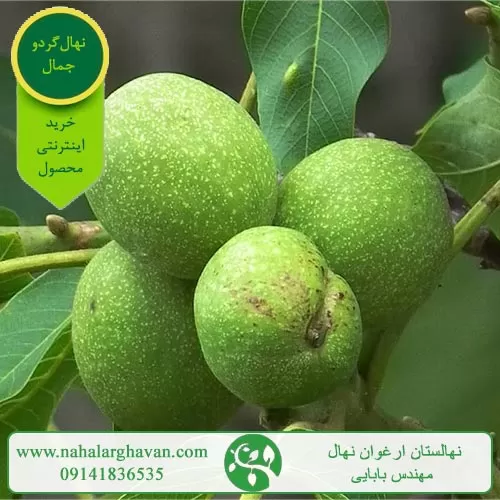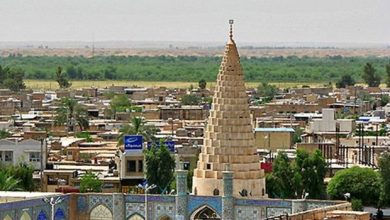What is the best fertilizer for nut trees and seedlings?
Walnuts and how to preserve them, as well as the best fertilizer for walnut trees, is the subject of our discussion in this article. In this article we will examine what is the best fertilizer for walnut tree and also discuss the issues surrounding it and if you intend to get complete information about this fruit and also the best suitable fertilizer for this fruit tree then you can read these purple read seedling articles at the end. stay with us

Review of the best fertilizer for walnut trees
Generally, before planting a walnut tree in the ground, walnut gardens are analyzed based on the size and area of the plot as well as the type of soil. The reason for this analysis is to examine the soil in the best way and make it so that when you plant the walnut seedling in the ground, the seedling should have enough strength to grow as well as to bear fruit. In general, the type of fertilizer as well as the amount of fertilizer depends on the type of soil in which the walnut seedlings will be grown.
The reason for this is that this fruit has many roots in the first years when it grows and takes root, and organic fertilizers or animal fertilizers with chemical fertilizers must be used in the winter in the form of compost nuclei in the shade. The tree must be hollowed out so that the walnut tree can provide the energy it needs to grow and bear fruit.
In order to add fertilizer to the land in which this fruit tree will be planted, a hole of one meter deep, 40 cm wide and one meter long must be dug and the required fertilizer poured into it. We must say that these holes must be kept in the shade of the tree. To fertilize trees over 15 years of age, one kilogram of potassium sulfate, 500 grams of zinc sulfate and 500 grams of iron sulfate should be poured over animal manure or premium fertilizer and should be mixed well. After mixing these fertilizers with each other and pouring them completely into the intended hole.
Soil suitable for growing walnut seedlings
In general, in order for the walnut seedling to be able to provide the energy it needs for growth and rooting, all kinds of animal and chemical fertilizers must be poured into the hole in which the walnut seedling will be planted. In general, the greater the depth and diameter of the hole in which the walnut seedling will be planted, the more favorable the conditions will be for the nut seedling. But in general, if you want your walnut seedling to be fertile in the best way and to reach fertility in the shortest time, you can dig a hole 1-2 meters deep and also suitable and fertilized soil inside it.
Of course, the thing I have to tell you about this issue is that your best option is to do it a few months or a few years before you plant the seedlings of these fruits in this area, because then the soil can do it. Create more favorable conditions for walnut seedlings. After the entire seedlings of these fruits are transplanted into the holes, the best thing to do is to cover the surface of the soil around the nut seedlings with rotten leaves and plant debris such as straw and wheatgrass in spring and summer. We can prevent water from evaporating and wasting around the roots of the nut tree, so that the nut seedlings can find and use more water.
Walnut cultivation solutions
As you know, in general, this fruit tree is a very large and wide tree and needs more light than other trees. When a walnut tree reaches maturity, it becomes fully fertile and bears fruit, and the parts of the nut tree that have received more light benefit from much better fruiting than other parts of the tree. Usually, walnut trees should be planted so that the distance between them is not less than 10 meters, because these trees, as said, are very large and wide trees, and after a few years their growth increased and the trees spread, disturbing each other and wrapping their leaves with each other, causing the leaves of the tree to fall off.
In general, the issue that has a great impact on the quality of walnut production is the type of seedling, soil quality, water and air quality, as well as the cultivation environment. In general, this fruit grows better in regions with a cool or temperate climate than in other regions, and if you plant walnut seedlings in such regions, better fruits can be obtained from them.
In the usual case, the nut tree is cultivated and propagated through walnut seeds, and the seeds of this fruit must be sown in another case at the age of two years, so that it can give a better and more consistent result. In general, the best season for planting seedlings is early spring. The issue that we must pay special attention to when planting seedlings is that the seedlings must be planted at a height of at least 20-30 cm above the ground so that they do not suffer after a period of black water disease and do not cause the seedlings to dry out. completely.
Introducing the best fertilizer to accelerate nut tree fruiting
When the seedling grows and is ready to bear fruit, it needs different fertilizers until it reaches maturity and after that include organic fertilizers and chemical fertilizers if necessary. These fertilizers contain useful and essential substances that must be supplied to the walnut tree through the root system or the leaves; Providing fertilizer for the rapid growth of the walnut tree helps a lot in improving the quality, taste and roughness of the kernels. Here is an introduction to the best recommended fertilizer for walnut trees:
Seaweed for lemon trees
If you want to get an organic, healthy and best quality product in the shortest time, don’t neglect Shockwave Seaweed Extract! This unique product is rich in micronutrients, Ascophyllonodosum algae extract, more than 60 kinds of growth-stimulating hormones and other ingredients that lead to the exponential growth of the nut tree. So this fertilizer is an excellent choice for the fast growth of a walnut tree.
Nitrogen fertilizer (urea, liquid nitrogen)
Nitrogen is one of the elements involved in the formation of chlorophyll for foliage, and its supply affects the amount of photosynthesis, leaf and shoot growth, and sugar formation. On the other hand, walnut trees urgently need nitrogen to produce protein, so take the application of nitrogen fertilizer at the beginning of growth seriously and use the correct amount and dosage for better yield.
High phosphorus fertilizer
Phosphorus is another highly used element that nut trees need to improve fertility because phosphorus leads to stronger roots and improved resistance to harsh environmental conditions, strength of leaves and stem cell walls, and increased energy exchange in the plant. The substitution of a high phosphorous fertilizer in the nut tree fertilization program is due to the fruit’s need for this element to fill the brain, prevent blackening of the brain, and better tree growth. Foliar application of high-phosphorus fertilizer paves the way for marketable nuts.
High potassium fertilizer
Potassium is so essential for fruit trees that the preservation of flowers and their transition to fruit depends on the presence of sufficient potassium. Potassium is an excellent source for fortifying nut trees against environmental stress and drought and triggers the growth of enzymes involved in fruit development. It is necessary to use a fertilizer with a high potassium content, after the nut has been cracked, to begin to increase in size and fill it up; Therefore, increase the quality of your nut kernels with this fertilizer.
according to:
shop.bayara.com
zain-roastery.com










